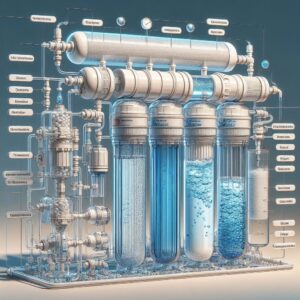The quest for pure water has been a constant endeavour throughout human history. As technology has advanced, the development of highly effective water purification methods has become a reality—one of the most prominent being the reverse osmosis process. This method has revolutionised the way we access clean drinking water, both for individual households and larger communities.
Unveiling the Reverse Osmosis Process
Reverse osmosis (RO) functions on a straightforward principle: it uses a semi-permeable membrane to filter out undesired molecules and ions from water. The term ‘reverse’ stems from the fact that, naturally, osmosis would cause the movement of water from an area of low solute concentration to an area of high solute concentration. However, in reverse osmosis, pressure is applied to overcome the natural osmotic pressure, effectively reversing the water flow through the membrane, leaving the contaminants behind.
What sets reverse osmosis apart from other filtration methods is the precision with which it can remove particles. Not just limited to sediment and larger contaminants, an effective reverse osmosis water filter can reduce or eliminate much smaller particles, including certain types of bacteria and viruses which conventional filters may not capture.
The Stages of Reverse Osmosis Filtration
In essence, reverse osmosis is a multi-stage process. Typically, it involves a pre-filtration stage where sediment and chlorine are removed to protect the RO membrane from damage or clogging. Water then proceeds to the reverse osmosis membrane—a synthetic liner that allows only water molecules to pass through under pressure, effectively blocking up to 99% of dissolved solids.
After passing through the RO membrane, the water usually enters a post-filtration stage using activated carbon filters to remove any remaining taste and odour impurities. Finally, processed water is stored in a holding tank, ready for use, while the rejected contaminants are flushed away.
Advantages of Using Reverse Osmosis
The benefits of a reverse osmosis system are far-reaching. By selectively removing a vast array of contaminants, from heavy metals to nitrates, pesticides and sulfates, RO systems can dramatically improve the safety and quality of drinking water. Moreover, an effective reverse osmosis water purifier bypasses the need to purchase bottled water, thus reducing plastic waste and contributing to environmental conservation efforts.
Another advantage is the taste of the water. Water filtered through reverse osmosis is typically fresher, cleaner, and devoid of odours. This makes it not only great for drinking but also beneficial for cooking, as it can contribute to the purity and flavour of the final dish.
Installation and Maintenance of Reverse Osmosis Systems
The installation of a reverse osmosis filtration system generally requires professional assistance to ensure correct setup and maximised efficiency. Once installed, maintenance routines are straightforward but essential. Periodic replacement of pre- and post-filters is necessary, typically every 6-12 months, while the RO membrane itself may last a few years with proper care. Regular system checks help maintain performance and prevent any potential issues.
It’s important to consider the local water conditions when selecting a reverse osmosis system, as high levels of certain contaminants like iron or manganese can require specialised pretreatment solutions to prevent permanent damage to the RO membrane.
The Impact of Pure Water Systems on Water Purification
Companies such as Pure Water Systems play an important role in providing innovative solutions for water treatment. They understand the importance of safe, clean, and palatable water for health and well-being. Driven by the need to provide superior quality water, these systems integrate seamlessly into homes and businesses, making it easier for individuals to access purified water.
Firms like Pure Water Systems not only supply the technology but also offer the knowledge and customer support necessary to maintain such systems over time, ensuring the longevity and reliability of the purification process. They provide the expertise required to make informed decisions about water treatment, tailored to the user’s specific context.
Environmental Considerations
Whilst reverse osmosis systems are efficient in purifying water, it is worth noting the environmental considerations surrounding their usage. The process generates wastewater, as concentrated solute is flushed away from the system. It’s critical that systems are well-designed to minimise unnecessary water waste and operate efficiently to offset this drawback.
Additionally, ongoing innovation in reverse osmosis technology is focused on energy efficiency and reducing the volume of wastewater generated during the purification process. These advances play a part in ensuring that the environmental impact of RO systems is lessened while the benefits to users are maximised.
Conclusion
The reverse osmosis process stands out as a milestone in water purification technology. With its ability to filter out a wide range of contaminants and improve the overall quality of drinking water, it has grown increasingly popular for residential and commercial use. The installation of a reverse osmosis water filter or purifier can be a significant step towards ensuring the health and environmental well-being of users around the world.
Ultimately, as demand for clean water continues to rise globally, the role of reverse osmosis and companies like Pure Water Systems in providing sustainable, high-quality water solutions cannot be overstated. By understanding and embracing the process of reverse osmosis, society can take a leap forward in securing safe and pleasant drinking water for generations to come.








